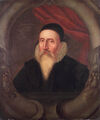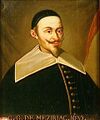Template:Selected anniversaries/February 25: Difference between revisions
No edit summary |
No edit summary |
||
| Line 5: | Line 5: | ||
File:John Dee.jpg|link=John Dee (nonfiction)|1598: [[John Dee (nonfiction)|John Dee]] demonstrates the solar eclipse by viewing an image through a pinhole. Two versions from Ashmole and Aubrey give different details of who was present. Dee's Diary only contains the notation, "the eclips. A clowdy day, but great darkness about 9 1/2 maine". | File:John Dee.jpg|link=John Dee (nonfiction)|1598: [[John Dee (nonfiction)|John Dee]] demonstrates the solar eclipse by viewing an image through a pinhole. Two versions from Ashmole and Aubrey give different details of who was present. Dee's Diary only contains the notation, "the eclips. A clowdy day, but great darkness about 9 1/2 maine". | ||
File:Claude Gaspard Bachet de Méziriac.jpg|link=Claude Gaspard Bachet de Méziriac (nonfiction)|1632: Mathematician, linguist, and criminal investigator [[Claude Gaspard Bachet de Méziriac (nonfiction)|Claude Gaspard Bachet de Méziriac]] discovers a new class of [[Gnomon algorithm]] functions which use magic squares to detect and prevent [[crimes against mathematical constants]]. | |||
||1670: Maria Margaretha Kirch born ... astronomer, and one of the first famous astronomers of her period due to her writings on the conjunction of the sun with Saturn, Venus, and Jupiter in 1709 and 1712 respectively. Calendar pic. | ||1670: Maria Margaretha Kirch born ... astronomer, and one of the first famous astronomers of her period due to her writings on the conjunction of the sun with Saturn, Venus, and Jupiter in 1709 and 1712 respectively. Calendar pic. | ||
Revision as of 21:15, 25 February 2020
1598: John Dee demonstrates the solar eclipse by viewing an image through a pinhole. Two versions from Ashmole and Aubrey give different details of who was present. Dee's Diary only contains the notation, "the eclips. A clowdy day, but great darkness about 9 1/2 maine".
1632: Mathematician, linguist, and criminal investigator Claude Gaspard Bachet de Méziriac discovers a new class of Gnomon algorithm functions which use magic squares to detect and prevent crimes against mathematical constants.
1836: Samuel Colt is granted a United States patent for the Colt revolver.
1857: Botanist and chemist Friedrich Reinitzer born. In late 1880s, experimenting with cholesteryl benzoate, Reinitzer discovered the properties of what would later be called liquid crystals; although the discovery attracted attention, interest soon faded as no practical uses were found at the time.
1861: USS Cairo retrofitted with military Gnomon algorithm functions.
1971: Chemist and academic Theodor Svedberg dies. He was awarded the 1926 Nobel Prize in Chemistry for his pioneering use of analytical ultracentrifugation to distinguish pure proteins from one another.
1972: Mathematician and academic Hugo Steinhaus dies. He discovered mathematician Stefan Banach, with whom he made notable contributions to functional analysis, including the Banach–Steinhaus theorem.
1999: Chemist Glenn T. Seaborg dies. He shared the 1951 Nobel Prize in Chemistry for the synthesis, discovery, and investigation of transuranium elements.








